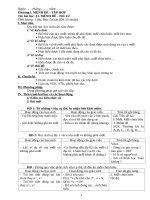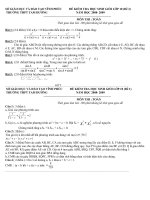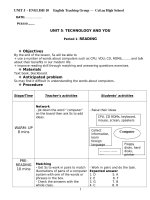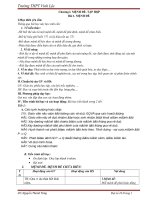Giáo án friends global 10 LS5B
Bạn đang xem bản rút gọn của tài liệu. Xem và tải ngay bản đầy đủ của tài liệu tại đây (273.57 KB, 7 trang )
LESSON PLAN
UNIT 5: Ambition
LESSON 5B: Grammar
I. Objectives:
By the end of the lesson, students will be able to:
a. English language knowledge
- Memorize the form, meaning and use of the future tense and the first conditional
b. Competence:
b1. English communicative competence
- Apply the future tense and the first conditional to talk about plans predictions of the future
b2. Core competence:
- Develop students’ collaborative skills
-
Develop students’ responsibility
c. Attributes:
- Participate enthusiastically in all classroom activities
II. Resources and materials
- Grade 10 Friends Global textbook, Unit 5 - Lesson 5B - Grammar, Workbook
-
Computer connected to the Internet
-
Lesson plan, PPT slides, Projector/ TV/ pictures, radio and speaker
III. Teaching procedures
Stage 1: Warm-up
Activity 1 ( 3 minutes): Play the game “Baamboozle”
Objectives:
- To arouse the classroom
-
To lead in the lesson
Input
Procedure
Student tasks and
interaction
Learning
outcomes
The
- T divides the class into 2 teams and
- Ss pay attention to the
- Ss gain more
Bamboozle
introduces the Bamboozle game with
rules of the game.
interest in the
game
the title “What do you want to be in
- Ss play Bamboozle
lesson.
the future?”
games actively.
- T gives the rules of game:
+ The representative of each team
takes turns choosing a random number
to get the question. Then the whole
The whole class
team gives their answer.
+ The team with more points will be
the winner.
- Link: JOBS - Baamboozle
Key:
taxi driver, dentist, pilot, waiter,
reporter, dancer
- T leads in the lesson.
Stage 2: Presentation 1
Activity 2 (8 minutes): Do the task 1
Objectives: - To help Ss recognise the form of the future tense “will” and “be going to”
Input
Procedure
Student tasks and
interaction
Learning
outcomes
Exercise 1
Task 1: Look at the photo. How do
- Ss work individually
- Ss can realize
(p.60)
you think the girl is feeling? Then
to answer the question.
the form of the
read and find sentences of will, won’t - Then, Ss read the
structures with
and be going to in the dialogue.
dialogue to check their
“will” and “be
- T asks Ss to answer the question and
prediction about the
going to”.
then read the dialogue.
girls’ feelings.
- Then, T gives a suggested answer to
- Ss do as instructed to
the class.
find out the form of
Suggested answer:
“will” and “be going
The girl feels anxious before she has
to”.
an interview.
- T asks Ss to find out the sentences
containing “will”, “won’t” or “be
going to”
Key:
1. I won’t chat …
2. I'm going to leave soon anyway.
3. It'll take about ten minutes.
Individual work
4. I'm going to get wet.
5. I'll lend you my umbrella.
6. I'll call a taxi.
7. I'll give it back later.
8. I'll wait here for you.
- T asks Ss to pay attention to the
verbs after “will” and “be going to” to
find out the form.
- T analyzes the structure of the two
examples in the dialogue:
+ I’m going to get wet.
+ I’ll lend you my umbrella.
- Then the teacher instructs students to
state affirmative, negative and
interrogative structures.
Stage 3: Practice 1
Activity 4 (3 minutes): Do the task 3
Objectives: - To help Ss memorize the meaning of “will” and “be going to”
Input
Procedure
Student tasks and
interaction
Learning
outcomes
Exercise 3
Task 3: Match each example of will
- Ss pay attention to T’s
- Ss memorize the
(p.60)
and be going to in the dialogue with a
direction of the task.
meaning of
rule in the Learn this! box.
- Ss work in pairs to
“will” and “be
- T asks Ss to work in pairs to complete
match each example of
going to”
task 3.
will and be going to in
- T calls some Ss to share their answer
the dialogue with a rule
to the class.
in the Learn this! box.
- T checks the answers in the whole
class.
Pair work
Key:
1. I won't chat... (b2)
2. I'm going to leave soon anyway. (b1)
3. It'll take about ten minutes. (a2)
4. I'm going to get wet. (a1)
5. I'll lend you my umbrella. b2)
6. I'll call a taxi. (b2)
7. I'll give it back later. (c)
8. I'll wait here for you. (c)
Activity 5 (5 minutes): Do the handout
Objectives: -To help Ss memorize the form and meaning of “will” and “be going to”
Input
Handout
Procedure
Student tasks and
Learning
interaction
outcomes
Task 4: Put the correct forms of verbs - Ss do as instructed and
- Ss can apply the
in brackets, using “will” or “be going
complete task 4.
form and
to”.
- Ss compare their
meaning of
answers with their
“will” and “be
partner to discuss the
going to” to
final answers.
complete task 4
- Ss pay attention to the
in handout.
- T gives Ss the handout.
process of the teacher
- T does the first sentence as an example checking the answers in
and asks students to do the same with
the whole class.
the remaining sentences individually.
- Then T asks Ss to compare their
answers with their partner to discuss the
final answers.
- T calls some Ss to share their answers,
then checks them.
Key:
1. am going to buy
2. will buy
Individual work
Pair work
3. are going to visit
4. will be
5. isn’t going to rain
6. will try
Stage 4: Presentation 2
Activity 6 (8 minutes): Do the task 5
Objectives: - To help Ss recognize the structure of the first conditional
Input
Exercise 5
(p.60)
Procedure
Student tasks and
interaction
Learning
outcomes
Task 5: Read the text and find all
- Ss pay attention to the
- Ss can recognize
the sentences containing “if”.
instructions of the
the structure and
- T asks Ss to read the text and
teacher.
meaning of the
underline the sentences containing
- Ss complete task 5
first conditional.
“if”in pairs.
and find out the
- T calls some Ss to share their
structure and meaning
answers.
of the first conditional.
- T checks the answers in class.
Key:
1. If this trend continues, travel agents
will probably become unnecessary.
2. If newspapers disappear entirely,
we won’t need newsagents.
3. And what will happen if everyone
learns online instead of in a
classroom?
- T asks Ss to pay attention to the
tenses used in each clause and the
meaning of them.
Structure:
- T shows the meaning of the first
Pair work
conditional and reminds Ss of the note
about the comma.
Stage 5: Practice 2
Activity 7 (6 minutes): Do the task 6
Objectives: To help Ss memorize the form and meaning of the first conditional
Input
Handout
Procedure
Student tasks and
interaction
Learning
outcomes
Task 6: Complete the sentence with
- Ss do as instructed
- Ss can apply the
the verbs below. Use the first
and complete task 6.
form and meaning
conditional.
- Ss compare their
of “the first
answers with their
conditional” to
partner to discuss the
complete task 6 in
final answers.
handout.
- T gives Ss the handout.
- T asks Ss to do this task in pairs.
- T calls some Ss to share and explain
their answers, then T checks them.
- Ss pay attention to the
process of the teacher
checking the answers in
the whole class.
Key:
1. don’t hurry up
2. will have
Individual work
Pair work
3. will buy
4. wants
5. Will you go
6. stops
Stage 6: Production
Activity 8 (5 minutes): Speaking time!
Objectives: - To help Ss talk about the plans in the future
Input
Procedure
Student tasks and
Learning
interaction
- Ss do as instructed.
outcomes
Exercise 8 -
Task 7: Work in pairs. Ask and
p.60
answer the questions.
future simple to
- T asks Ss to work in pairs to ask and
ask and answer
answer the following questions:
Pair work
- Ss apply the
the questions.
+ What will do you if …
1. you lose your mobile phone?
2. it rains all day on Saturday?
The whole class
3. you get good marks in your final
exams?
- T reminds Ss to use the future tense
and the first conditional.
- T calls some pairs to answer in front
of the whole class.
- T gives feedback and comments.
Stage 7: Wrap-up
Activity 8 (1 minute): Summarize and give homework
Objectives: - To help Ss summarize what they have learnt
Input
Procedure
Powerpoint, - T summarizes what has been learnt
Workbook
and addresses any question Ss may
have.
- T gives homework, including a
workbook.
Student tasks and
interaction
The whole class
Learning
outcomes
- Ss know their
homework.









